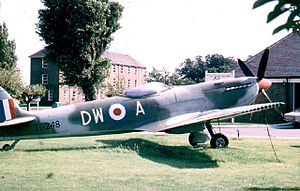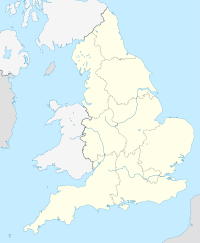| RAF Sealand
| |
|---|---|
| Part of Flintshire | |
| Located near Queensferry, Wales | |
 Spitfire LF16 gate guardian on display at RAF Sealand's East Camp in 1975. | |
| Type | Royal Air Force station |
| Site information | |
| Owner | Ministry of Defence |
| Site history | |
| Built | 1916 |
| In use | 1916-2004 |
| Demolished | 2005 |
| Battles/wars | |
| Garrison information | |
| Garrison |
Royal Flying Corps (1916-1918) Royal Air Force (1918-1951) United States Air Forces In Europe (1951-1957) Royal Air Force (1957-2004) |
Royal Air Force Station Sealand or more simply RAF Sealand was a Royal Air Force station in Flintshire, north Wales and operated between 1916 and 2006.
Under defence cuts announced in 2004 RAF Sealand was completely closed in April 2006. All remaining RAF units were moved to RAF Leeming. Part of the original airfield is now operated as the civilian MoD Sealand.
Early history[]
It was originally a civilian airfield and was taken over by the military in 1916 for training. Two twin hangars, which were built in 1917, were used by the newly formed Royal Flying Corps. Originally named RFCS Shotwick and later RAF Shotwick, the station was finally named RAF Sealand during World War II.
Immediately pre-war and in the early war years, it was the home of No 5 FTS (Flying Training School), equipped with Airspeed Oxfords. During the war, the Flying Training Schools provided what was in effect intermediate training for pilots who had received ab initio training and flown solo at an EFTS (Elementary Flying Training School) and who had subsequently been inducted into the RAF. Pilots thus arrived at No. 5 FTS RAF Sealand as APOs (Acting Pilot Officers) and upon satisfactory completion of intermediate training became POs (Pilot Officers), and were prepared for posting to a squadron or OTU (Operational Training Unit). Kenneth Cross spent time at No. 5 FTS as an instructor in the early 1930s. From 5 August 1940, the CFI (Chief Flying Instructor) was Edward Mortlock Donaldson. Amongst the pilots who trained at No 5 FTS, RAF Sealand was Johnnie Johnson.
No. 30 Maintenance Unit RAF was formed there in 1939. Two years later No. 19 Elementary Flying Training School (EFTS) equipped with Tiger Moths was located at RAF Sealand. In 1951 the station was taken over by the United States Air Force. It was handed back to the RAF in 1957.
Operational station[]
Sealand was a communications support base for RAF operations around the world. It functioned as a third-line repair station for avionics equipment for all three services.
Examples of equipment serviced : C12 Directional Gyroscope (Hercules), and other gyroscopic based navigational equipment.
No 631 Volunteer Gliding Squadron operated at Sealand between 1963 and 2006, most recently flying the Viking TMk1 conventional winch-launched glider.
In March 2006, No 631 VGS relocated to RAF Woodvale to operate the Grob109b 'Vigilant' self-launched motorglider.
Civilian Technical Training school[]
Home to the Civilian Technical Training School giving training in avionics, radio, radar and flight instrumentation. The school also trained TTOs (Trainee Technical Officers), ATTs (Avionics Trainee Technicians), and apprentices.
The following apprenticehips were offered:
- Craft Technician
- Instrument Maker
- Electrical
- Radio Technician
Recent History[]
- 1994 - 2000 D.C.S.A Defence Communication Services Agency
- 2000 - 2004 D.A.R.A Defence Aviation Repair Agency
- 2004 - 2006 A.B.R.O
- 2006 - Defence Support Group
Current use[]
The Electronics Business Unit of the Defence Support Group (DSG) occupies part of the original Sealand site since the closure of the RAF station in 2006. The business unit is responsible for the repair and maintenance of Avionic equipment and operates as part of a Trading Fund of the Ministry of Defence.
The MOD has contemplated using the site for several purposes, one of the most controversial of which was the idea to turn RAF Sealand into an emergency prison to cope with overcrowded prisons in England and Wales.
Sealand's ranges are still used for shooting, where cadets from the services come to either compete or practice shooting.
External links[]
| Wikimedia Commons has media related to RAF Sealand. |
- DSG
- Plans for housing announced
- D.A.R.A
- A.B.R.O
- D.C.S.A Defence Communications Support Agency
- 631 Gliding web site
- DE&S Defence Equipment & Support
- BBC News article
- DSG History
Coordinates: 53°13′20.75″N 2°59′52.65″W / 53.2224306°N 2.9979583°W
The original article can be found at RAF Sealand and the edit history here.
